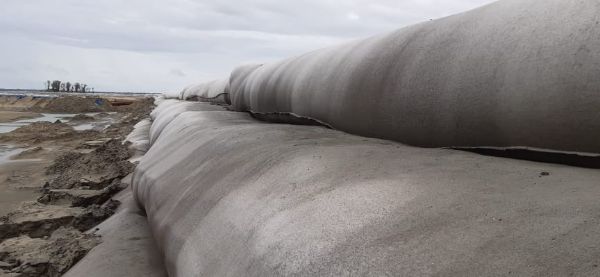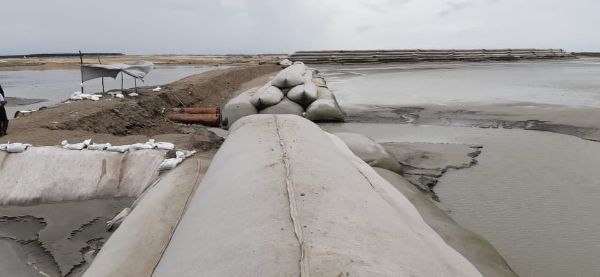Geotube
Geotube dewatering vessels are a dewatering device made of a specifically developed textile that confines small particulates inside the vessel while allowing water to pass through engineered textile. The solids proceed to stiffen and solidify as the water discharges.
After the solids have fully solidified or fulfilled the minimal criteria for transportation, the dewatered materials can be disposed of in a variety of ways. Geotube dewatering containers are constructed into tubular, sack like, or other shapes with loading ports or other arrangements for site filling utilizing high resilience and grade seaming processes.

Benefits of Using Geotube
All across the globe, geotube dewatering technologies has established the technique of preference for wastewater processing plants. The following are the key benefits of dewatering technologies.
- High-volume diminution and solids conservation are achieved with this extremely efficient technique.
- Clean filtration that may be refueled via the mechanism and a strong wastewater outflow rate.
- Containers that are specially made conserve money and valuable ground area.
- Solids are easily removed and disposed of.
- Carbon footprint is reduced by using an efficient, adaptable, and environmentally friendly solution.
- In all climatic situations, it is dependable, and it eliminates functional safety hazards.
- It is economical, untroublesome, and time-saving.
- For many sediment dewatering purposes, it offers a remarkably efficient and environmentally beneficial option.
- These are reliable for durable geosynthetic non-woven fabric.
- Geotubes are preventive to acids, alkalis, UV and biodegradation.
- Excellent puncture and abrasive resistance
- Available in White and Grey colour.
Applications of Geotube
The procedure is straightforward but effective, making it excellent for:
- Industry of pulp and paper
- Lagoon cleaning, both primary and secondary
- Railings are removed by mining and mineral processing.
- Sludge from the coal industry
- Sewage treatment plants in cities
- Remediation of the sea
- Utilities & power
- Paper and pulp
- Industrial light
- Agriculture including the dairy farming, abattoirs and others are all examples.


- Agriculture including the dairy farming, abattoirs and others are all examples.
- Aquaculture
- Marine construction and reformation.
- Dewatering sludge from ponds, canals, lakes, etc.
- Mining and mineral processing.
- Offshore structure
- Breakwaters
How Does Geotube Container Works?
Sludge dewatering with Geotube is a three-step procedure:
Filling and bulking
The dredging debris or slurry is pumped into the Geotube first. The inclusion of ecologically friendly flocculants speeds up and facilitates the adsorption of solid debris, allowing the liquid/water to be separated.
Geotextile tube Dewatering
During this process, excessive water flows from the Geotube's porous geotextile layer. Dewatering results in a significant reduction in waste volume. Based on the wastewater descant's grade, it is generally subjected to much farther processing or securely released into waterways and aquatic bodies without remediation.
Geotextile Tube Consolidation
The solid residue in the Geotube proceeds to dry and stiffen after dewatering. Dewatering sludge with Geotubes results in a quantity decrease of about 90%.The Geotube is eventually cut apart, and the solid debris is taken out to be disposed of.
GEOTEXTILE Tube technical specifications of Polypropylene
Property |
Value |
|---|---|
|
Length
|
4 meter to 60 meter |
|
Width |
2 meter to 6 meter |
|
Diameter |
1.25 meter to 4 meter |
GEOTEXTILE Tube specifications of Polyester Fabric
Property |
Value |
|---|---|
|
Length
|
4 meter to 60 meter |
|
Width |
2 meter to 6 meter |
|
Diameter |
1.25 meter to 4 meter |
Material Specification
Fabric |
Non-Woven Geotextile |
Color |
|---|---|---|
|
Polypropylene & Polyester Fabric |
Yes
|
White or Grey |
** We also accept custom size orders for products.
Have a Smaller Project?
If you have a smaller dewatering project we cover that as well. In addition to the large sludge tubes, we also offer several small Dewatering Silt Bags to help filter out sediment and materials. These bags typically include sizes between 1m x 0.23m and 50m x 0.23m.
In order to determine the right option for your location, consider several factors:
- Type of solids you are filtering
- How many geotextile dewatering tubes are required for the amount of solids you are dewatering
- Areas available for placement of the dewatering tubes
- Clear understanding of where the filtered water will flow
Our Projects
Project: Cox's Bazar, Bangladesh Army
Project: Matarbari Port, Super Petrochemical Ltd.
Project: Payra Bondor, Patuakhali
FAQ
Geotube systems are used for shoreline erosion protection, land reclamation, island creation, wetlands creation, construction platforms, revetments, dykes, groynes and offshore structures.
When waves crash against the shore, they strike the tube first, minimizing the amount of time the shoreline and dunes are exposed. Geotextile tubes assist to keep sand and shorelines in place, preventing additional erosion and loss.
Geotextiles have been expected to last for up to 200 years. By virtue of its chemical composition, molecular structure, and thermodynamic properties, polypropylene is one of the most resistant organic raw materials known today, preventing additional erosion and loss.
Geotube dewatering containers are prefabricated using high strength and quality seaming techniques into tubular, bag-like, or other forms with filling ports or other provisions for site filling. The containers are custom sized to save land space and are ideal for areas where space is a constraint.
Why Choose B. J. GEOTEXTILE LIMITED?
B. J. Geo-textile Limited Geotube is a dewatering geotextile tube designed for excessive moisture sludge, tailings, or dredging spoils. Geo-tubes are popular because of their convenience and cost-effectiveness. They are made of high-capacity and high-modulus Polyester and Polypropylene.
Dockyard and ports, coastal defense, dams and flood defenses, substantial debris in dumps, and sludge ponds cleanup are all applications for Geotube dewatering technologies. Wastewater recycling process can assist to alleviate the current water issue.
The Geotube dewatering method is the favored choice for wastewater treatment across the world because it is highly easy and cost-effective. Unlike other technical and commercial procedures, the complete process is odorless and noiseless. Geo tubes by B. J. GEOTEXTILE LIMITED are projected in Cox’s Bazaar and Matarbari Port in Bangladesh.
Many government and private projects across the world use our Geo Tube systems. We place a premium on meeting worldwide standards as well as the diverse needs of our clients. Our Geo-tubes come in a variety of sizes to accommodate various volumes and space needs.
Conclusion
Geotube technology has helped enterprises all around the world in order to defend their coastal areas and deliver low-cost, high-volume dewatering options. Geotube constructions have been created and modified for more than 40 years to enable engineers handle formerly insoluble jobs. They began as a single layered unit built for coastline erosion defense.
The B. J. Geotextile Limited Geo Tube stacking technique is one of the most notable developments. By collaborating with our clients to create sophisticated solutions, B. J. GEOTEXTILE LIMITED manufactures and creates products that serve to boost functionality, decrease cost, and give demonstrable outcomes.
The comprehensive details of our product will help you to get the most structured geotextile tube instantly at B. J. GEO-TEXTILE LIMITED. Therefore, if you are looking for the specially engineered geotextile tube feel free to contact us instantly.

